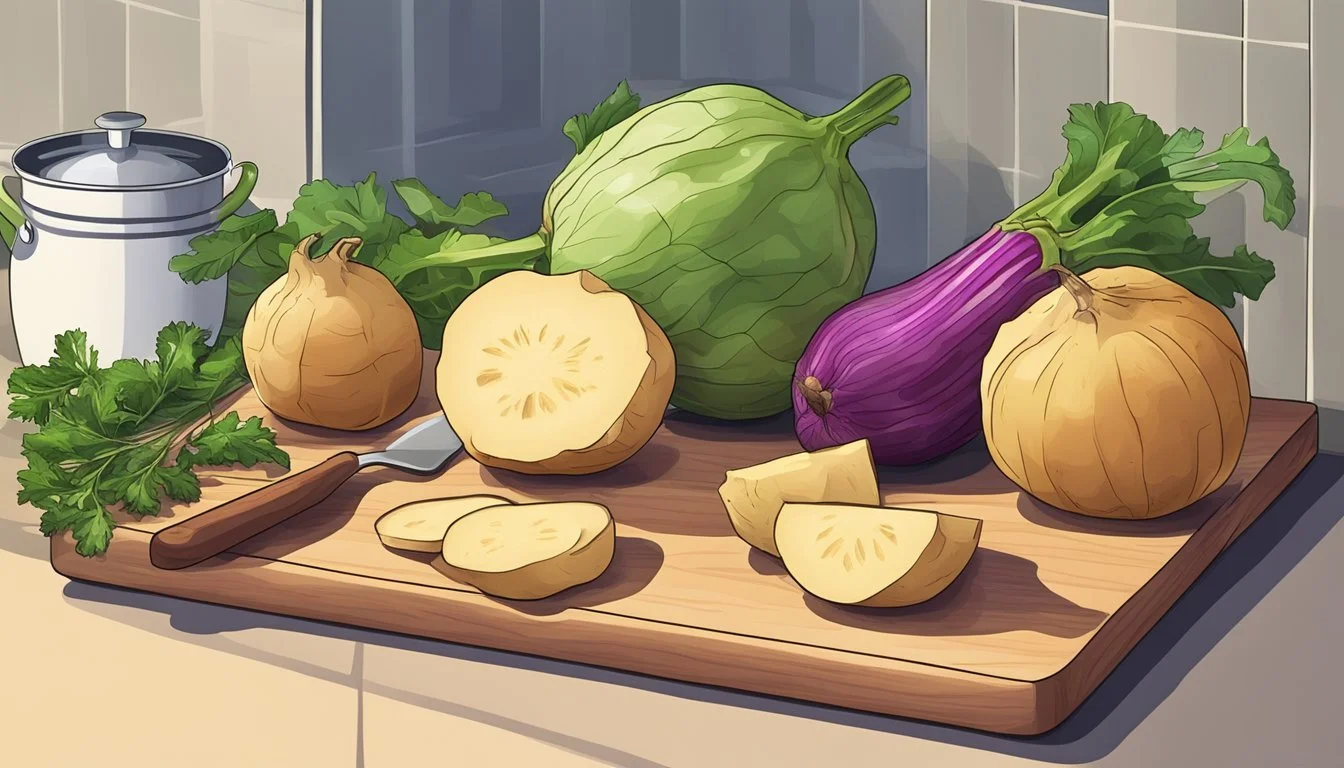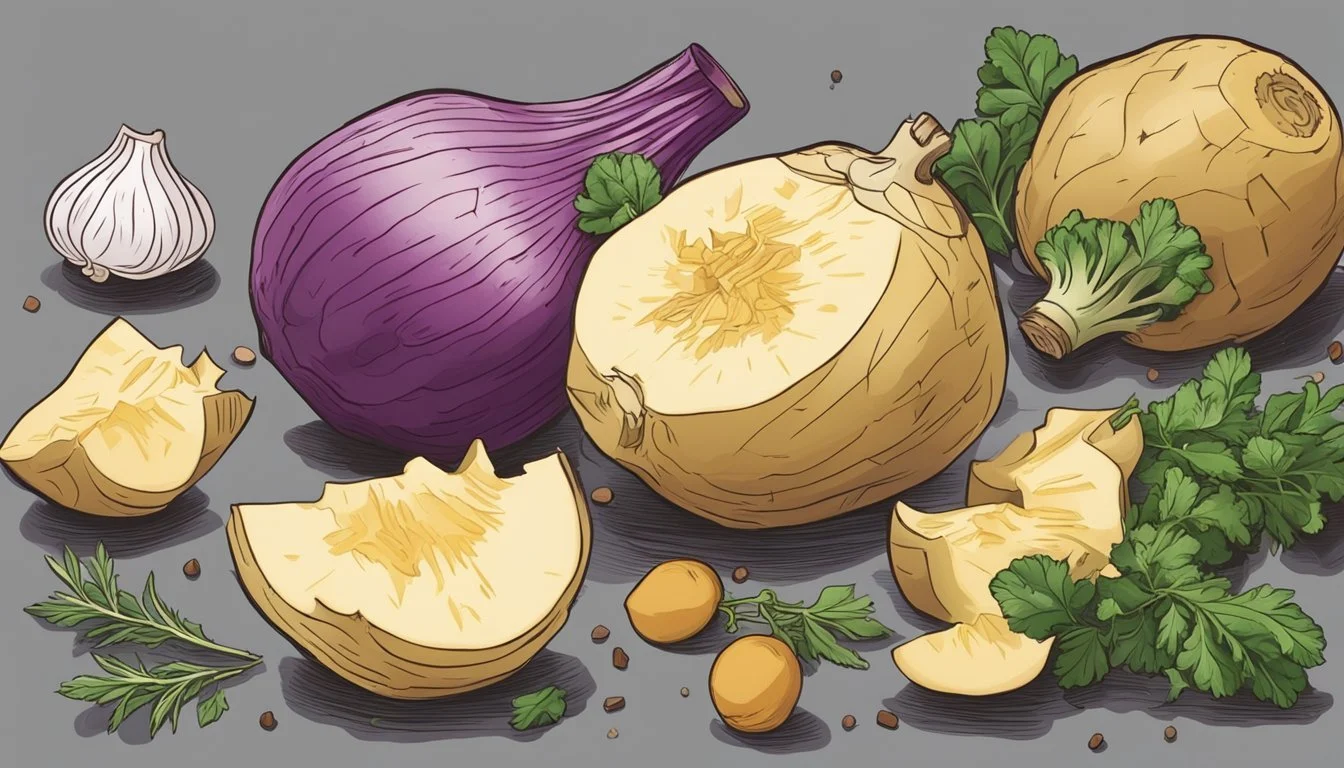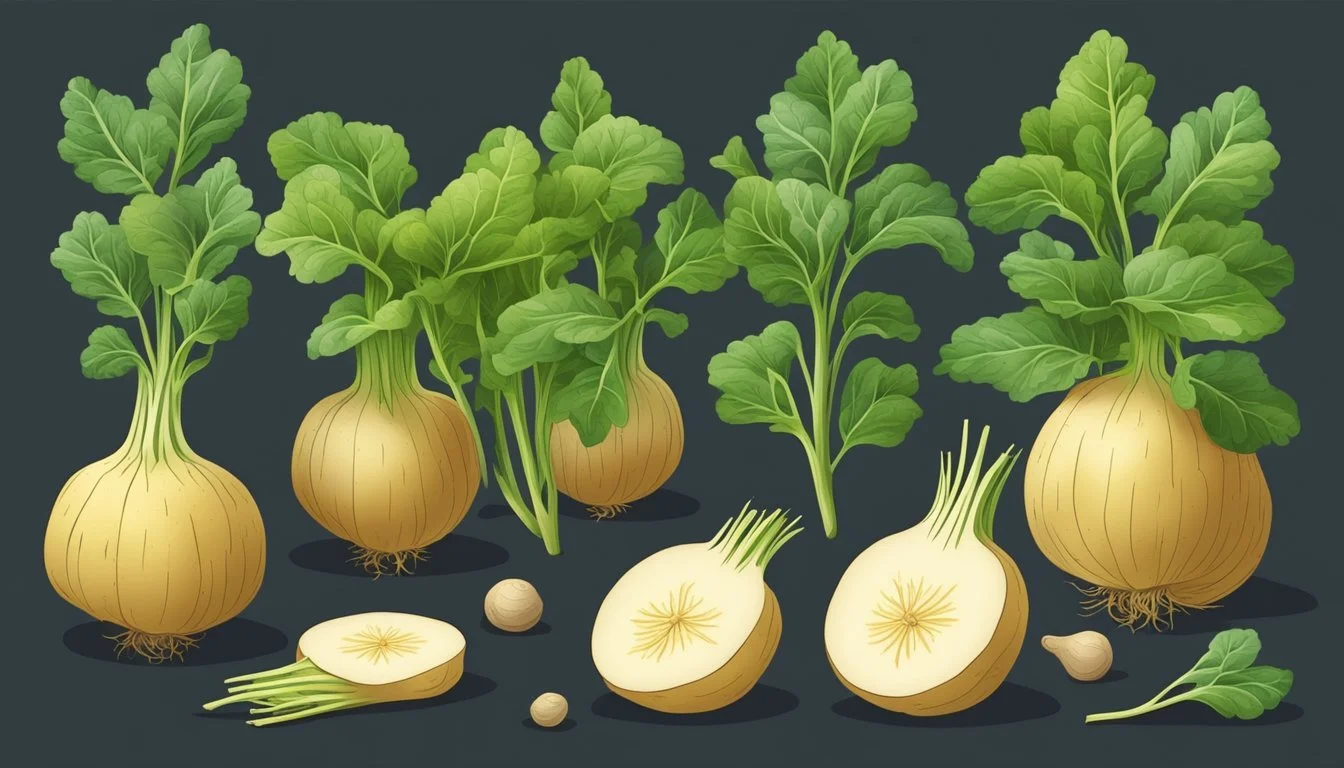How to Cook with Rutabaga for Starchy Sides
Mastering Hearty Vegetables
Rutabagas, hearty root vegetables with a reputation for being versatile and nutritious, make for a healthy addition to any diet. Rich in vitamins C and E, potassium, and fiber, these starchy sides are more than mere fillers. When cooked properly, rutabagas offer a savory and slightly sweet flavor that can enhance a variety of dishes ranging from mashes to bakes. With their dense texture, they are often a substitute for potatoes, providing a lower-calorie option for those mindful of their intake.
The preparation of rutabagas is straightforward. Start by peeling the tough outer skin to reveal the pale yellow flesh within. This root vegetable can be cubed for roasting to bring out its natural sugars, or it can be boiled and mashed for a smooth, creamy side dish. Incorporating ingredients like butter, spices, and herbs can elevate the taste of rutabagas, creating a side that is both wholesome and satisfying.
Understanding what rutabagas are, and recognizing their potential in the kitchen, is essential for anyone looking to diversify their culinary repertoire with healthy but flavorful options. As a root vegetable, it takes well to various cooking methods, which means it can readily adapt to numerous recipes. Cooking with rutabagas is not just a means to a nutritious end, but a culinary exploration of one of fall and winter's underappreciated gems.
Understanding Rutabaga
Rutabagas are a nutritious root vegetable often overlooked in comparison to their close relatives, turnips and cabbage. They offer a unique flavor and a plethora of nutritional benefits, making them a valuable addition to starchy sides.
Nutritional Profile
Rutabagas are low in calories but high in fiber, contributing to digestive health and satiety. They contain important vitamins and minerals such as vitamin C, potassium, and iron. Here's a brief overview of their nutritional content per 100 grams:
Calories: ~38 kcal
Protein: 1.1 g
Fat: 0.2 g
Carbohydrates: 8.62 g
Fiber: 2.3 g
Sugars: 4.46 g
Vitamin C: 25% of the Daily Value (DV)
Potassium: 305 mg
Iron: 2% of DV
Rutabaga vs. Other Root Vegetables
When compared to other root vegetables, rutabagas are often likened to turnips due to their similar shape and texture. However, they tend to be larger, have a yellow-orange flesh, and a sweeter, milder taste. In the context of other starchy vegetables:
Calories: Rutabagas have fewer calories than many other starchy vegetables, making them a lighter choice.
Carbohydrates: Their carbohydrate content is on par with turnips but lower than that of potatoes.
Vitamin C: Rutabagas are a particularly good source of vitamin C, rivaling that of some leafy greens.
Fiber: They provide a comparable amount of dietary fiber to other root vegetables, which is essential for a healthy digestive system.
Using rutabagas can add nutritional value to meals with fewer calories and a moderate carbohydrate count, all while bringing a unique flavor to the table.
Preparation Basics
Cooking with rutabaga begins with a few essential steps to ensure the vegetable's natural flavors are maximized. From selecting the best specimen at the market to dicing it for your favorite recipe, these basics are pivotal to creating delicious starchy sides.
Selecting and Storing
When choosing rutabaga at the store or farmers' market, one should look for firm and heavy specimens without any soft spots or cracks. A medium-size rutabaga is generally preferable as it is less likely to be fibrous. To store, place rutabagas in a cool and dry place, ideally in the vegetable drawer of the refrigerator, where they can stay fresh for up to a month.
Cleaning and Peeling
Before cooking, thorough cleaning is necessary. Ingredients such as dirt or debris should be scrubbed off under cold running water. Using a vegetable peeler, one should remove the skin, as it can be tough and bitter. It is essential to peel until the yellow flesh is exposed to ensure that all the woody exterior is removed.
Cutting Techniques
The dense nature of rutabaga requires a sharp knife for cutting. Start by slicing off the top and bottom to create a stable base. The vegetable can then be sliced or diced depending on the recipe's needs.
Slice: Cut the rutabaga into thin or thick rounds, and then cut into half-moons if desired.
Dice: For a dice, first cut slices, then stack them and make a series of cuts both lengthwise and crosswise to create cubes.
For even cooking, ensure pieces are uniform in size. One might season the prepared rutabaga with salt, pepper, olive oil, or butter. Adding garlic powder can also enhance its savory notes. Combined with ingredients like sweet potato, the prep time increases slightly but results in a richer, more colorful dish.
Cooking Methods
Rutabaga can be transformed into a delicious starchy side through various cooking methods, each contributing to the final texture and taste. Understanding these techniques will help ensure that rutabaga is cooked to perfection, whether it's mashed, roasted, or fried.
Boiling and Mashing
Boiling rutabaga is a classic approach before mashing. For tender results, cut the rutabaga into even chunks and boil them in water for 20 to 25 minutes. A fork should easily pierce the flesh when it's ready. After draining, one can mash the rutabaga with butter, seasoning it with salt and pepper to enhance its natural sweetness.
Total time: 30 minutes
Cook time: 20-25 minutes
Ingredients:
Rutabaga, evenly chopped
Water, enough to cover the chunks
Butter
Salt and pepper
Roasting
Roasting enriches rutabaga's sweet and earthy flavors while providing a satisfyingly crisp exterior. Preheat the oven to 425°F and toss 1-inch rutabaga cubes with olive oil, salt, and pepper. Spread them on a roasting pan and cook for 45-55 minutes until golden and tender.
Total time: 1 hour
Cook time: 45-55 minutes
Roasted Rutabaga Recipe:
Rutabaga, peeled and cubed
Olive oil
Salt and pepper
Sautéing and Frying
Sautéing or frying gives rutabaga a caramelized exterior with a soft interior. Heat oil in a pan over medium heat, then add rutabaga slices or cubes, cooking until they develop a golden color and are cooked through. This method is quicker than roasting and can incorporate a variety of flavors based on the seasoning used.
Total cook time: Varies, until golden and tender
Fried Rutabaga:
Rutabaga, sliced or cubed
Oil for frying
Seasonings of choice
Seasoning and Flavor Enhancement
Proper seasoning and flavor enhancement are crucial for transforming the earthy taste of rutabaga into a delightful starchy side. Whether mashed, roasted, or grilled, rutabaga's natural sweetness and tender texture offer a canvas for a range of flavors.
Herbs and Spices
Salt: A fundamental seasoning to enhance the natural flavor of rutabaga.
Black Pepper: Adds a sharp and woody aroma, complementing the vegetable’s sweetness.
Garlic Powder: Imparts a savory note; use sparingly to prevent overpowering.
Thyme: Provides a subtle minty and floral taste well-suited for roasted or boiled rutabaga.
Rosemary: Its pine-like flavor pairs beautifully with the sweetness of rutabaga, especially when roasting.
Fat and Acid Balancing
Olive Oil: Ideal for roasting, adding richness while promoting carmelization.
Butter: Adds creaminess to mashed rutabaga, enhancing its smooth texture.
Avocado Oil: A high-smoke point alternative for roasting, offering a nutty flavor.
Utilizing fats not only helps in cooking but also carries and melds the flavors of herbs and spices used.
Complementary Ingredients
Sweet Potatoes: Combine with rutabaga to heighten the sweetness and create a complex side dish.
Parchment Paper: Use when roasting to avoid sticking and ensure even cooking without the need for excessive oil.
Each complementary ingredient should be chosen to accentuate rutabaga's sweet and tender qualities while contributing to the overall balance of the dish.
Rutabaga-Based Side Dishes
Rutabaga, a starchy root vegetable, offers a sweet and earthy taste ideal for a variety of side dishes. When included in recipes, it has the potential to complement main dishes with its rich texture and versatility.
Salad and Slaw Options
Rutabaga can be used raw in salads and slaws, providing a delightful crunch. Here's a quick recipe modification for a refreshing side:
Ingredients: Thinly sliced rutabaga, grated carrots, diced apples.
Dressing: A vinaigrette of olive oil, apple cider vinegar, mustard, honey, salt, and pepper.
Combine the sliced rutabaga with carrots and apples. Toss with the dressing for a crisp and zesty side dish.
Root Vegetable Medley
Oven roasted rutabaga combined with other root vegetables like carrots, turnips, and potatoes can create a rustic and hearty side. Here's a simplified cooking method:
Preheat the oven to 425º F (220º C).
Chop the vegetables into uniform pieces.
Toss with olive oil and season with salt and pepper.
Roast until they are golden brown and tender, about 20-30 minutes.
This medley transforms into a sweet and caramelized mixture, perfect alongside soups or stews.
Rutabaga Puree and Mash
For a twist on mashed potatoes, rutabaga can be boiled until fork-tender and then mashed or pureed into a smooth side dish. Here's the process:
Cook rutabaga in boiling water with added flavorings like bay leaves and thyme.
Drain and remove herbs.
Mash with butter, cream, and optionally a touch of honey for sweetness.
Serve this delicious mash as a comforting side, velvety and rich in flavor, suitable for any dinner table.
Serving and Presentation Tips
Presentation is as crucial as the preparation in serving rutabaga. Proper plating, pairing, and garnishing elevate the mild taste and texture of this nutritious root vegetable, enhancing the overall dining experience.
Plating Techniques
When serving rutabaga, whether mashed, roasted, or cubed, maintaining the integrity of its texture is important. For a visually pleasing plate, serve the rutabaga in neat, cube-sized portions alongside the main course, providing a contrast to softer foods on the plate. When presenting mashed rutabaga, use a scoop or piping bag to create attractive, symmetrical portions that highlight its creamy texture.
Pairing with Main Courses
Rutabaga, with its mild, slightly sweet flavor, complements a variety of main courses. Pork chops, (What wine goes well with pork chops?) with their rich flavor and savory notes, pair exceptionally well with the starchy side. Alternatively, a fresh rutabaga side dish, with its low sodium content, balances well with heartier, saltier mains. For a vegetarian option, consider pairing roasted rutabaga with greens or a medley of other root vegetables like roasted potatoes to create a colorful and nutritious plate.
Garnishing for Visual Appeal
Garnishes should provide not only a pop of color but also a subtle taste enhancement that complements the main flavors of the dish. Fresh parsley is a classic choice that adds a bright, herby note to the dish. One might also consider fine slices of green onion or chives for a hint of sharpness that counterbalances the sweetness of swede, commonly known as the Swedish turnip.
Dietary Considerations
When cooking with rutabaga, one can address various dietary needs such as low carbohydrate diets and gluten-free, vegetarian preferences. Rutabaga offers nutritional benefits including being a source of fiber, calcium, and vitamin A, while remaining low in net carbs, saturated fat, and cholesterol.
Low-Carb and Keto-Friendly Options
Rutabaga is a suitable starchy side for those on low-carb and keto diets due to its lower net carb content compared to other root vegetables. When boiled, rutabaga contains approximately 9 grams of net carbs per 100 grams. It's also a healthful option, providing a decent amount of fiber which is essential for digestive health.
Boiled Rutabaga: A simple preparation that can be mashed or pureed for a low-carb mash alternative.
Roasted Rutabaga: Cubes can be roasted with oil and seasoning, offering a side dish with a reduced carb count.
Gluten-Free and Vegetarian Adaptations
Thanks to its versatility, rutabaga easily fits into gluten-free and vegetarian dishes (What wine goes well with vegetarian dishes?). It doesn't contain gluten, making it a safe choice for individuals with celiac disease or gluten sensitivity. It also serves as a hearty base for vegetarian recipes, contributing essential nutrients like calcium and vitamin A without the need for animal-based products.
Vegetarian Rutabaga Recipes: Whether it's roasted, boiled, or mashed, rutabaga can be seasoned with herbs and spices to suit vegetarian palates.
Gluten-Free Side Dishes: Rutabaga-based sides avoid gluten-containing ingredients and can provide a satisfying addition to any meal.
By considering these dietary adaptations, rutabaga offers a versatile and nourishing choice for those with specific dietary considerations.
Preserving and Storing Cooked Rutabaga
After cooking, preserving rutabaga properly ensures that its starchy goodness can be enjoyed for longer. Below are the best practices for refrigerating and freezing cooked rutabaga to maintain its flavor and texture.
Refrigerating
Cooked rutabaga can be stored in the refrigerator for up to three to five days. For optimal freshness, it should be:
Cooled: Allow the rutabaga to cool to room temperature before storing.
Sealed: Place it in an airtight container to prevent it from absorbing odors and flavors from other foods.
Freezing Techniques
When freezing cooked rutabaga, the goal is to retain its texture and taste:
Portion Size: Divide into serving sizes for easier use later.
Freezing Precaution: Spread the rutabaga in a single layer on a tray, freeze until solid to prevent clumping.
Storage Containers: Transfer to freezer bags or airtight containers, removing as much air as possible.
Reheat: To retain a golden brown color, reheat in an oven or on a stovetop until heated through.
By following these methods, one can ensure cooked rutabaga maintains its quality.
Rutabaga Throughout the Seasons
Rutabaga, also known colloquially as 'neeps', is a versatile root vegetable that thrives in the cold climate, making it an excellent choice for fall and winter meals. Its hearty texture allows for a wide range of culinary uses throughout the year.
Fall and Winter Favorites
During the fall and winter months, when the chill sets in, rutabaga takes a leading role in the kitchen. This starchy side can be transformed into warm, comforting dishes that are particularly fitting during these seasons. A popular way to prepare rutabaga during this time includes:
Boiled and mashed: Often complemented with butter and seasonings such as bay leaf and thyme.
Rutabaga's ability to store well also means it can provide a substantial base for many meals, from stews to casseroles, pairing wonderfully with seasonal spices.
Year-Round Usage and Variations
Rutabaga's robust nature makes it an exceptional choice for year-round cooking, not just during its peak seasons. Here are ways one can incorporate rutabaga into their diet throughout the year:
Roasted: Cut into chunks and combine with olive oil, salt, and preferred seasonings. Roast until brown spots appear and the texture softens.
Grilled: Slice and brush with oil, garlic powder, or spices, then grill to add a smoky flavor.
Its mild yet distinct taste can accompany almost any meat or vegetable, highlighting rutabaga's adaptability to a variety of dishes and cuisines.








